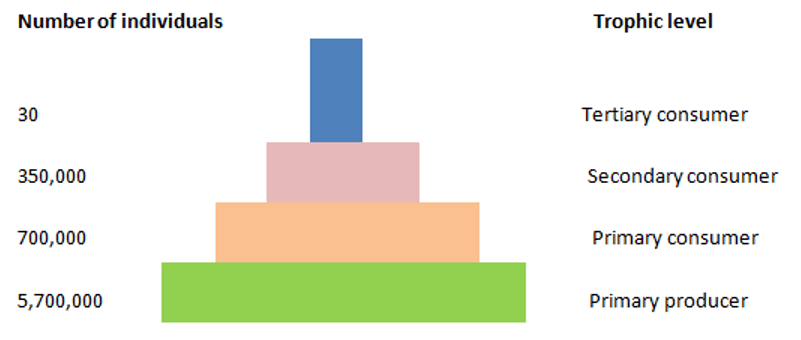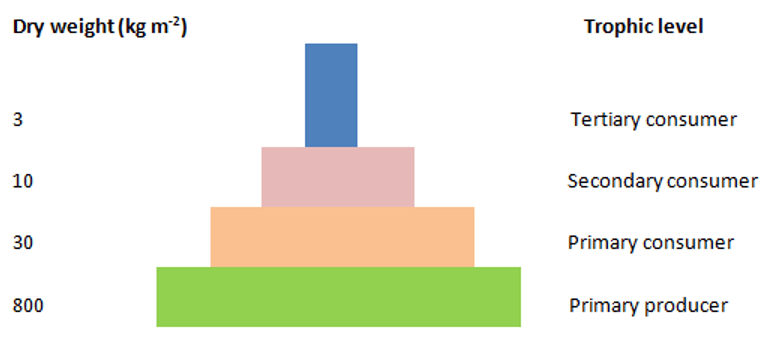This set of Class 12 Biology Multiple Choice Questions & Answers (MCQs) focuses on “Ecological Pyramids – 2” for Pharmacy Entrance Exam.
1. Which of the following represents the relationship of prey being more than predators?
a) Age structure
b) Pyramid of number
c) Ecological succession
d) Environmental issues
View Answer
Explanation: The relationship of prey being more than predators is represented by the pyramid of numbers. It represents the number of individuals at each level (producers forming the base and top carnivores forming the tip).
2. On which basis is the idea of productivity of an ecosystem based?
a) Pyramid of biomass
b) Pyramid of number
c) Ecological succession
d) Pyramid of energy
View Answer
Explanation: The idea of productivity of an ecosystem is based on the pyramid of biomass. The total dry weight of the total amount of living matter at each level (from producers to consumers) is represented by the pyramid of biomass.
3. What does the pyramid of number and pyramid of biomass represent?
a) The rate of production of food
b) The relationship among the organisms
c) The rate of respiration
d) The rate of loss of energy
View Answer
Explanation: The relationship among the organisms is represented by the pyramid of number and pyramid of biomass. The pyramid of number represents the number of individuals at each level while the total dry weight of the total amount of living matter at each level is represented by the pyramid of biomass.
4. What does the pyramid of energy indicate because of which it is said to be the best representation of an ecosystem?
a) Number of all plants and animals
b) Rate of respiration
c) The total rate of photosynthesis
d) The rate of energy flow through the food chain
View Answer
Explanation: The pyramid of energy is said to be the best representation of an ecosystem because it indicates the rate of energy flow through the food chain. Depending upon the nature of the food chain, the pyramid is always upright.
5. How many types are do ecological pyramids have?
a) Thirteen types
b) Two types
c) Three types
d) Five types
View Answer
Explanation: There are three types of ecological pyramids. They are the pyramid of energy (upright), the pyramid of number (inverted or upright) and the pyramid of biomass (inverted or upright).
6. On what is the pyramid of numbers based on?
a) The energy at each trophic level
b) Individuals in a trophic level
c) Biomass content at each trophic level
d) The area at each trophic level
View Answer
Explanation: The pyramid of numbers represents the number of individuals at each level (producers forming the base and top carnivores forming the tip). Depending upon the nature of the food chain, the pyramid is inverted or upright.
7. In a stable ecosystem, whose inverted pyramid is not observed?
a) Food
b) Number
c) Biomass
d) Energy
View Answer
Explanation: If an ecosystem is stable, the pyramid of energy is upright. The pyramid of energy is said to be the best representation of an ecosystem because it indicates the rate of energy flow through the food chain.
8. Though the pyramid of energy is always upright, what decreases at successive trophic levels from producers to consumers?
a) Number of all plants and animals
b) The area at each trophic level
c) Energy content
d) Ecological succession
View Answer
Explanation: Though the pyramid of energy is always upright, the energy content decreases at successive trophic levels from producers to consumers. At each level, some amount of energy is lost into the surroundings in the form of heat.
9. Which of the following is the lowest in number, if plants, grasshopper, birds, and lion are the components of an ecosystem?
a) Birds
b) Grasshopper
c) Plants
d) Lion
View Answer
Explanation: If plants, grasshopper, birds, and lion are the components of an ecosystem, the least number is obtained by a lion. This is because, the lion being the top-most consumer in an ecosystem, it gets the least amount of food and energy since these things are lost at every level.
10. Which of the following has maximum numbers, if plants, grasshopper, birds, and lion are the components of an ecosystem?
a) Grasshopper
b) Lion
c) Plants
d) Birds
View Answer
Explanation: If plants, grasshopper, birds, and lion are the components of an ecosystem, the maximum number is occupied by plants or producers. This is because plants being the primary producers are placed at the bottom and they receive the maximum amount of energy.
11. What is the position of herbivores in a pyramid of biomass?
a) First
b) Second
c) Third
d) Fourth
View Answer
Explanation: The total dry weight of the total amount of living matter at each level (from producers to consumers) is represented by the pyramid of biomass. The herbivores obtain the second position if the pyramid of biomass is upright.
12. What is the position of producers in the pyramid of energy?
a) Zero
b) Second
c) First
d) Third
View Answer
Explanation: Though the pyramid of energy is always upright, the energy content decreases at successive trophic levels from producers to consumers. The producers gain the first position in the pyramid of energy because they have maximum energy.
13. In a pond ecosystem, which organisms are present in the maximum number?
a) Producers
b) Consumers
c) Decomposers
d) Scavengers
View Answer
Explanation: The consumers are present in the maximum number in a pond ecosystem. The pyramid of energy and number is upright while the pyramid of biomass is inverted in a pond ecosystem.
14. What does the following pyramid represent?

a) Pyramid of biomass
b) Pyramid of energy
c) Pyramid of age
d) Pyramid of number
View Answer
Explanation: The following pyramid represents the number of individuals in an ecosystem. As in the figure, this number increases at every trophic level and the pyramid is upright.
15. What does the following pyramid represent?

a) Pyramid of biomass
b) Pyramid of energy
c) Pyramid of age
d) Pyramid of number
View Answer
Explanation: The following pyramid represents the amount of biomass/productivity of the ecosystem at each level. As in the figure, the amount of biomass decreases at with the increasing level and the pyramid is upright.
Sanfoundry Global Education & Learning Series – Biology – Class 12.
To practice all chapters and topics of Biology for Pharmacy Entrance Exam, here is complete set of 1000+ Multiple Choice Questions and Answers.
If you find a mistake in question / option / answer, kindly take a screenshot and email to [email protected]
- Practice Class 12 - Physics MCQs
- Practice Class 12 - Chemistry MCQs
- Check Class 12 - Biology Books
- Practice Class 11 - Biology MCQs
- Practice Class 12 - Mathematics MCQs
